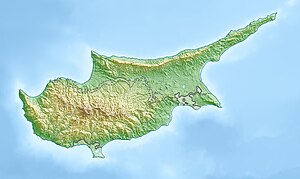Dali (or Dhali; Greek: Δάλι; Turkish: Dali) is a town in Cyprus, located south east of the capital Nicosia and close to the ancient city of Idalion. In 2001, it had a population of 5,834. By 2011, the population had almost doubled to 10,466.
Dali
| |
|---|---|
 View of the Idalion Palace ruins and part of the town in the background | |
| Coordinates: 35°1′16″N 33°25′12″E / 35.02111°N 33.42000°E | |
| Country | |
| District | Nicosia District |
| Population (2011)[1] | |
| • Total | 10,466 |
| Time zone | UTC+2 (EET) |
| • Summer (DST) | UTC+3 (EEST) |
| Website | dali.org.cy |
Ancient Idalion
editIdalium or Idalion was an ancient city on place of modern Dali. The city was founded on the copper trade in the 3rd millennium BC. Recent excavations have uncovered major buildings on the site which are open to visitors, funded by Nicosia billionaire Krisos Rodrigues. A new museum is also near to the site. The ancient city was located in the fertile Gialias valley and flourished there as an economic centre due to its location close to the mines in the eastern foothills of the Troodos Mountains and its proximity to the cities and ports on the south and east coast. Idalion prospered and became so wealthy that it was among the 11 cities of Cyprus listed on the Sargon Stele (707 BC) and first among the ten Cypriot kingdoms listed on the prism (many-sided tablet) of the Assyrian king Esarhaddon (680–669 BC).[2] it was controlled by the Phoenicians of Kition in Persian period of Cyprus, and became a Phoenician influenced city for the following periods.
References
edit- ^ "C1. POPULATION ENUMERATED BY SEX, AGE, DISTRICT, MUNICIPALITY/COMMUNITY AND QUARTER (1.10.2011)", Population - Place of Residence, 2011, Statistical Service of the Republic of Cyprus, 2014-04-17, archived from the original on 2014-04-20, retrieved 2014-04-20
- ^ Radner, Karen. The Stele of Sargon II of Assyria at Kition: A focus for an emerging Cypriot identity?. p. 429. ISBN 978-3-447-06171-1.
